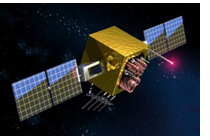
Fig. 1: Image Of Satellite In Space
It all started with basketball-sized pack of technology known as Sputnik 1. World’s first ever satellite was launched on October 4, 1957 by Soviet Union. Weighing 183 pounds, it took around 98 minutes to orbit Earth. While launch of the satellite was just a single event, it marked the beginning of space age and steered new military, political, scientific and technological developments.
The seed of its invention was sown back in year 1952, when International Council of Scientific Unions came to a decision of establishing July 1, 1957-December 31, 1958 as International Geophysical yr. It was decided so because scientists knew solar activity cycle would be at high points around this time. And eventually, council took up a resolution calling launch of the artificial satellites during International Geophysical yr. for mapping Earth’s surface.
White House declared plans of launching earth orbiting satellite and requested proposals from different governmental research agencies for undertaking development in July 1955. Vanguard proposal by Naval Research lab was picked for representing U.S during International Geophysical yr. And launch of Sputnik revolutionized everything. The technical achievement of Sputnik was that it did not just grab world’s attention but America’s public off-guard too. The size of this satellite was impressive as compared to Vangaurd and anticipated payload of 3.5 pounds. Additionally, public feared Soviet’s ability to commence satellites also translated to capability for launching ballistic missiles that could be used to transfer missiles from Europe to U.S. After that, Soviet’s had hit back with launch of Sputnik II on November 3, 1957.
Also, immediately after the launch of Sputnik 1, Defense department of U.S retorted to political disturbance with fund approval for Satellite project. Later as an alternative to the Vangaurd, work was initiated on Explorer project. Eventually, U.S launched Explorer 1 on January 31, 1958.
And the race into space did not end here; new way of viewing earth came into being. First ever aerial pictures were taken centuries ago by a hot air balloonist. Balloons were used for gathering military intelligence at the time of U.S civil war until their non immunity to gunfire was noticed. After that, many attempts were made to view ground from height including use of little cameras, kites or pigeons too. But effective aerial photography was not initiated until passenger on airplane snapped a scene of ground in year 1908.
Another revolutionizing element that the satellites brought was cellular telephones. These telephones have made communication not easy but handy too. Staying connected is easy as a pie with these phones. In the year, 1976 February, COMSAT launched MARISAT, a new type of satellite for offering mobile services to US Navy and all other marine clients. And in no later time, Europeans also commenced MARECS series for providing same services in 1980. Maritime organization UN international had funded INMARSAT in year 1979. And INMARSAT leased MARECS and MARISAT satellite transponders initially but soon in 1990 October started its own satellite named INMARSAT II F-1. Third generation of the satellite has been commenced too.
The contract of building an aeronautical satellite was given to General Motors in mid 1970s but was cancelled soon and IMARSAT provided the service. Perceived as means of offering traffic monitoring and telephone services on ships initially but it has offered a lot more than that. Gulf War brought the technology to public notice.
Many companies have worked hard to present version of Personal Communication System with the use of satellites in the Low Earth Orbits (LEO). As compared to initial LEO satellites, these systems orbited around 500 miles below belt. Among most ambitious LEO systems, Iridium by Motorola ruled the roost. At an altitude of 400 miles, it planned to start 66 satellites in the polar orbit. All the six orbits had 11 satellites each. And it started offering communication services of the cellular phones back in 1998. Apart from the large scaled LEO systems, there were many small ones too. But these companies planned to provide limited services, basically radio and data determination. Classic of these was known as ORBCOM which has now become a global leading provider of cellular data communications based asset management, tracking and remote controlling.
By 20th century’s end, around 2,200 satellites were orbiting the planet with many of them offering scientific data with shots of earth that were not even imagined before. Along with latest imaging techniques, satellites bestow ordinary human beings with super sight. Remote sensing uses aerial photography and lets humans’ view, which is otherwise not possible with an unaided eye. Different techniques allow identification of vegetation, soil, seasonal crops, mineral resources and changes brought around by floods and storms. These are also use for detecting surface temperatures, finding out groundwater movements. The key ability of remote sensing device is that it can see energies in the wavelength that is not visible to the human eye. Remote sensing, which is just a step child of space age, is prying many innermost secrets of Earth.
Filed Under: Invention Stories


Questions related to this article?
👉Ask and discuss on Electro-Tech-Online.com and EDAboard.com forums.
Tell Us What You Think!!
You must be logged in to post a comment.